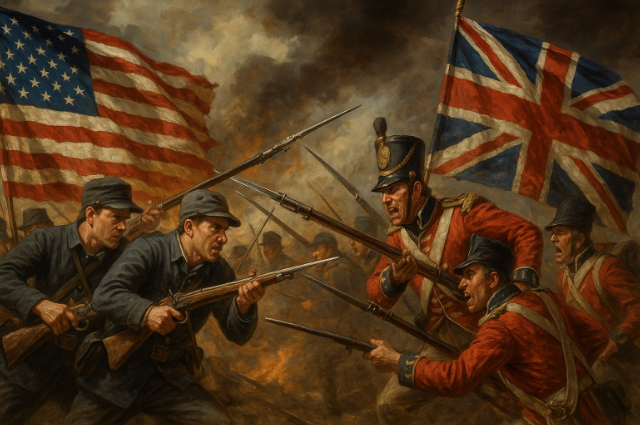
After a long and bloody war with the British, the United States of America gained independence on 4th July 1776. One would have believed that peace would prevail with no further confrontations. However, a problem arose when the British and American governments realised that there was no clear boundary between the USA and Canada. Since both the US and Canada were under British control before the war, there was no need for a border between them. This resulted in tens and hundreds of meetings between both governments, which lasted for almost a hundred years. As a matter of fact, the maps used by both governments were… just wrong. For eg, the Mississippi River was depicted in the wrong place, the Lake of the Woods, which was irregular in shape, was assumed to be circular and so on.
This ambiguity even led to a war in 1812, when the US attacked Canadian territories. However, it proved to be a stalemate, and both nations were back to the drawing boards, but this time, they had updated maps. After more than 34 years, both nations agreed to sign a treaty, the Oregon Treaty. This treaty was preceded by the Oregon dispute, wherein both nations were again at the brink of war since both wanted to occupy the Oregon region beyond the Rocky Mountains on the Western frontier. However, neither wanted to escalate the issue and signed the treaty instead. The treaty stated that a straight line shall be drawn from the northwestern point of the Lake of the Woods to the 49° N latitude. From there, it would continue straight till the end of the continent, leaving Vancouver Island in British hands. Sadly, there was another loophole in this!
The left region is Vancouver Island, and on the right is Oregon. The treaty did not mention which of the three routes shown in the figure the border would follow. Both nations wanted the islands of San Juan and made their respective claims. Gradually, over the years, people from both nations started occupying the islands, strangely without any conflicts… only for now!
On one hand, the US taxed and sold off animals like sheep and pigs belonging to the Britishers, considering they were on American soil. On the other hand, the British tried to arrest the Americans because they were on… well, British soil. Nevertheless, there was no major fight until 1859, when one pig decided that it was time to start a war!
Lyman Cutler was an American farmer who came to the island believing it to be American. He built his house on an open sheep farm since he was lazy enough to build it elsewhere. Besides, he did not fence his crops on all four sides since he thought animals would understand that they shouldn’t eat them! A perfect guy to start a global war!
As it was, a pig wandered into his farm and ate his potatoes. Chasing it off a few times, Lyman had had enough and one fateful day, he picked up his shotgun and killed the pig. It wasn’t an ordinary murder, but the start of a cascade of international events! The Briton, Charles Griffin, demanded compensation of $100, a huge sum at that time. Lyman was willing to pay $10. But Griffin said no! Furious, Lyman declared that he would shoot any sheep, pig or even Griffin if they dared enter his property. This made Griffin approach the British authorities, who sent officials to Lyman’s house demanding compensation.
Just so, a US Brigadier General, William S. Harney, commanding the military of Oregon, happened to pass by the island. Upon knowing the situation, he made the American settlers sign a petition requesting military help against the British. Afterwards, he sent Captain George Pickett with 66 soldiers of the 9th Infantry Regiment to the island to prevent the British from settling there. Responding to the American occupation, the Governor of Vancouver Island sent three British Royal Navy warships. As a matter of fact, again, both the British government back in London and the American government in Washington, DC, did not know about the escalating situation. Hence, everything was under the control of the British authority on Vancouver Island and Brigadier General William S. Harvey.
For days and months, both parties received reinforcements, but without a single bullet fired. Finally, when word reached both governments, they were shocked! Both immediately sent out officials to negotiate for peace and prevent a large-scale war. Upon arrival on the island, the American head of the army reportedly scolded Brigadier General Harney and Captain Pickett for nearly starting a war over a small pig. Consequently, a joint military occupation was decided, with both the British and American troops living on the island in harmony. And this time, it was indeed harmonious!
Soldiers from both camps visited each other, celebrated festivals, and organised sporting events. But the question of who the San Juan Islands belonged to still lingered. It wasn’t solved for 12 years, during which America went into a civil war while also souring its relationship with Britain. At last, with no options left, Britain and the US decided that an international arbitration, headed by the German Emperor Wilhelm I, would decide who the Islands belonged to. On 21st October, 1872, the San Juan Islands were finally given to the Americans and within a month, the British vacated the islands.
The Pig War stands as a subtle reminder that even a small potato-loving pig can trigger two nations into going to war with each other. Thanks to the cool heads of the British and American officials, who arrived on time, a minor issue that could have spiralled into another deadly war was negotiated. This incident also sheds light on the imperfections of treaties and the loopholes that man-made laws carry. In the end, this bizarre standoff gave birth to an era of peaceful resolution and marked the final step in defining the U.S.-Canada border.
